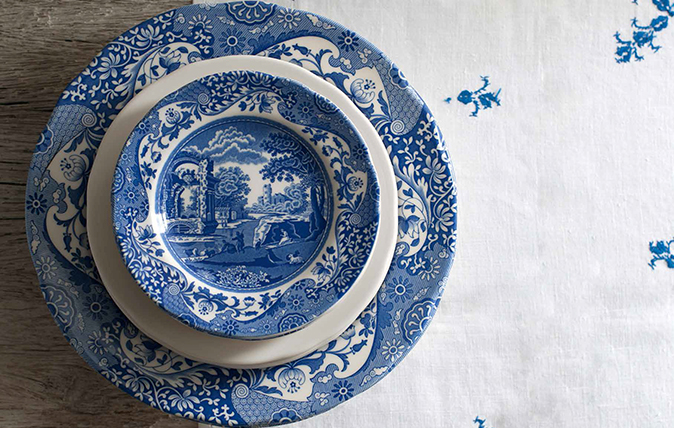Spode celebrates 200th anniversary of iconic Blue Italian pattern
As Spode’s iconic Blue Italian pattern turns 200, Annunciata Walton looks back at its history, how it introduced bone china to the world and how it has recently been saved from the brink of ruin.


What country kitchen exists without the adornment of English bone china? Blue- and-white porcelain, epitomised by Spode’s enduringly popular Blue Italian, which celebrates its bicentenary this year, is a ubiquitous part of our heritage and national psyche. as we eat our toast and marmalade from blue-and-white plates and sip coffee from a bone-china mug, we’re surrounded by crumbling ruins, ethereal flowers, twittering birds and Oriental curlicues. If Staffordshire is the birthplace of our beloved cups and saucers—it is, after all, the international capital of crockery—then Spode is the Stoke-born king.
By the early 18th century, the area around what is now Stoke-on-Trent —a conglomeration of six separate towns (the Potteries), united in 1910 and elevated to the rank of city in 1925—was well known as a pottery centre. This was nothing new—the potters of the 1700s were simply doing as the Romans had done, and the Saxons, too. they’d all cottoned onto the fact that the abundance of coal and clay in the local soil plus the easy access to the River Trent made this an ideal spot for an essential craft.
Although blue-and-white teaware was in vogue, the market was dominated by Chinese imports and potters across Europe were desperate to find a way to produce the same fine, white porcelain themselves.
Step forward the three Josiahs. When Josiah Spode founded his pottery works in 1776, he was following the example of his friend and neighbour Josiah Wedgwood, whose Grecian-inspired Jasperware was already a roaring success. Within a decade, Spode had mastered the industry-defining technique for underglaze transfer and produced the first Willow-patterned crockery.
The Willow motif—now 232 years old and most famously made by Minton’s, whose founder, Thomas Minton, originally designed it for Spode—clearly shows the fashionable influence of Oriental imports. Its cult was enhanced by an accompanying legend, inspiration for the design, about star-crossed Mandarin lovers who escaped across the seas and were turned into doves—this all vaguely makes sense if you put your nose to a Willow-patterned plate and examine it closely.
Soon after Willow’s arrival, Spode and Wedgwood were joined in the Potteries by the Minton’s and Copeland factories and later Burleigh. As Britain’s reputation for obsessive tea-drinking grew, fuelled by trade with the East Indies, pottery’s popularity soared and Spode prepared to break new ground again, turning his attention to porcelain, a much finer material than earthenware or stoneware.
Through experimenting with burnt animal bones, particularly ox bone, Josiah Spode created a unique, calcareous ingredient and, in 1796, introduced ‘bone china’ to the world. this strong and chip-resistant, yet translucent, soft-paste porcelain is the reason that English china is called fine. Today, most British firms, from Wedgwood and Royal Doulton through to Portmeirion and Royal Worcester, still use a variation of Spode’s formula.
Exquisite houses, the beauty of Nature, and how to get the most from your life, straight to your inbox.
After his father’s death, Josiah Spode II took over, partnering with local potter William Copeland to bring Spode triumphantly to the forefront of the early-19th-century Golden age of English ceramics. Soon, he was the proprietor of the largest works in the Potteries and, in 1806, he was appointed Potter to the Prince of Wales.
And so it was that, when Blue Italian was launched in 1816, it couldn’t have met with a more eager audience. Its Imari Oriental border of exotic flowers and scrolls gave a nod to the industry’s history, but within dwelt a fairytale as pretty as a picture. The scene is the Italian countryside: a shepherd and his lady tend their flock by a river that meanders lazily past a picturesque ruin, two lovers hold hands on the riverbank and, beyond, the river curves dotingly around a tiny chapel towards a medieval castle on high.
Trees and flowers permeate the landscape, both earth and sky, as if Man and his soft-edged edifices are there merely by Nature’s benevolent wish, and clouds scud overhead, reminding us that blue and white come in so many beautiful hues.
The company was eventually acquired by the Copeland family, who steered it through five generations of Victorian extravagance. Romance prevailed for a time, with whimsical patterns such as Byron Views, but, soon, a fussier, ornamental style became the order of the day, with huge orders for statues, busts, fireplace surrounds, doorknobs, tiles, figurines, spittoons, officers’-mess services, footbaths, vases, plaques and hotel and souvenir wares exported to all corners of the Empire, delighting the likes of Indian princes, European collectors and the American populace.
Indeed, America is as entranced with fine English china as ever—an estimated 30 million Spode Christmas tree pieces, a pattern introduced in 1938, are currently in use in America alone.
The Spode factory went into over- drive; between 1833 and 1900, some 35,000 new patterns were introduced—an average of 10 each week. However, none of these, not for all the gilding, regal Rococo and vibrant curlicues in greens, pinks and blacks, has endured as long as Blue Italian.
By the end of the 19th century, Spode was just one of more than 300 potteries operating in the Staffordshire area. Of course, some were more reputable than others and copycats looking for gullible customers were rife—’Vedgwood’ tea service, anyone?
The porcelain and earthenware craze continued beyond the First World War, with young housewives keeping the factory in business. throughout, Spode stuck to its high standards, using top-quality clay to create a durable, non-crazing product with a covetable silky glaze.
A variety of transfer-printed patterns was also produced at this time, often reissues of designs introduced by the younger Spode; these included Chinese Rose, India tree and ‘Spode’s Italian’ (so called to distinguish it from its imitators).
Most extraordinary of all was the skill that went into creating every single piece. Engravers would spend months at a time perfecting a pattern, meticulously punching holes into a copper plate. A heated cobalt colour was then smeared across the copper and allowed to sink into the indents, before the pattern was imprinted onto a delicate tissue paper, which was then ‘transferred’ (through vigorous rubbing, followed by glazing and firing) onto the china itself. This process had to be repeated to accommodate varying sizes of plate, platters and cups.
It’s a wonder that something as simple as holes in a copper plate can produce such richly layered artistry. Blue Italian epitomises this, but later designs also became classics. The hunt, based on paintings by J. F. Herring, although no longer produced, has endured and the Spode Copelands gave a nod to Art Deco and Modernist styles as well, recruiting sculptor Eric Olsen to design animal figures, often in a matte-green Royal Jade glaze, and comical Toby jugs, as well as more minimalist ceramics.
In the 1960s, Spode passed out of the hands of the Copeland family and merged with Royal Worcester. Sadly, traditional techniques began to seem obsolete, outplayed by cheaper, quicker computerised design and lithographic printing. Despite this, Spode clung to its skilled workmanship, even creating some of its most acclaimed series in this period, such as English Cathedrals, Military Regiments, British Birds, Woodland and Sporting Fish, as well as collectible royal-occasion commemorative ware and a reissue of Blue Room, still in production today.
Disaster finally struck when, in 2007, to public outrage, much of Spode’s production was outsourced to the Far East. Most termed the result a poorer quality product that was—let’s call a Spode a Spode—no longer English. A year later, after 230 years of continuous use, Spode’s Stoke works closed and the company went into receivership; it seemed as if the death knell of a centuries-old industry had sounded.
However, like a phoenix from the kiln-fired ashes, Spode has risen. In 2009, it was acquired by the Portmeirion Group and production has returned to the UK, to a site just a couple of hundred yards from the original factory. The hand-engraved designs are now applied using complex digital technology, with each punched hole in a copper plate a fragment of a bigger picture, and Spode continues to delight with reissues and new patterns, such as Delamere Rural and Glen Lodge, which features tartan, pheasants and stags.
Once derelict, the original factory site reopened earlier this year, under local-authority ownership, to house a museum for the extensive Spode collection and workshops for local creative businesses. What’s more, Staffordshire University, which runs a number of ceramics courses, is set to move half its campus close by, hopefully bringing a much-needed influx of young craftspeople back to pottery making.
With the popularity of modern brands such as (Stoke-based) Emma Bridgewater revitalising the industry, not to mention Wedgwood’s classic Beatrix Potter nurseryware and recent collaborations with Vera Wang and Jasper Conran, our venerable Blue Italian has a lot to compete with, but I reckon it can hold its own. after all, it’s been around for 200 years—it’s got nothing to be blue about.
For more information visit www.spode.co.uk
Annunciata is director of contemporary art gallery TIN MAN ART and an award-winning journalist specialising in art, culture and property. Previously, she was Country Life’s News & Property Editor. Before that, she worked at The Sunday Times Travel Magazine, researched for a historical biographer and co-founded a literary, art and music festival in Oxfordshire. Lancashire-born, she lives in Hampshire with a husband, two daughters and a mischievous pug.
